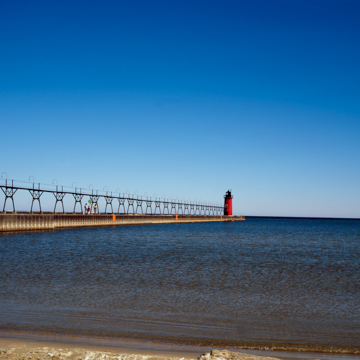From the outer end of the South Haven south pier head, this telescoping, cylindrical, riveted, steel-plate structure has aided navigation at the harbor at the Black River outlet to Lake Michigan since 1903. In 1902 the federal Lighthouse Board replaced the old 1872 wooden building with a metal pier-head beacon. A Milwaukee firm fabricated the cast-metal work for the tower's modular sections, and the U.S. Lighthouse tender Hyacinth shipped the steel and plate metalwork from Milwaukee across the lake, where it was assembled on the pier.
The tapered, 36-foot red stack measures 11.5 feet in diameter at the base. It is capped by an observation deck that is encircled by a wrought-iron railing decorated with latticework. On the deck rests a lantern with a sixth-order Fresnel glass lens, the smallest in magnitude and the lowest in intensity of the lenses invented by French physicist Augustin Fresnel in 1822. The roof is topped with a ventilator pommel and a lightning rod. A catwalk supported on H-shaped trusses extends the full length of the pier, from the lighthouse to the shore.
The South Haven South Pier Light represents the group of harbor lights built after the Civil War on newly constructed piers. Unlike those on the mainland, pier lights had no residences for keepers. This pier light is one of the smaller steel-frame skeletal lights erected on Lake Michigan. The catwalk is one of four remaining; others are at St. Joseph, Grand Haven, and Manistee. In 2010 the U.S. Coast Guard no longer needed the light and offered to transfer it to the City of South Haven, who may operate it in partnership with the Historical Association of South Haven and the Michigan Maritime Museum.


